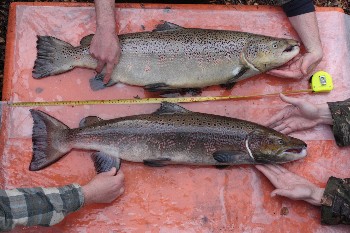Salmon spawning imminent
Posted: Tuesday 17 November, 2009 @ 08:42:26

November is traditionally the wettest month of the year in Wester Ross. Going by the past week or so, November 2009 looks set to be true to form. This is good news for spawning fish. November is also peak spawning time for wild trout and salmon.
At the end of October we watched sea trout and salmon jumping at a waterfall as they tried to reach headwater spawning streams in the upper Gruinard catchment. Given a good spate, some of them might have made it. More recently we've had good views of wild brown trout spawning: a golden hen trout of 40cm turning on her side to excavate a depression in which eggs would be laid; darker male trout in combat at the tail of the pool, 'bow waving', with much splashing and fins emerging from the water. November is the best month of the year for fish watching: many keepers and ghillies make time to walk river banks to see whether or not rod catches are a true reflection of how many salmon are in their river.
Several estates have supplementary stocking programmes. Small numbers of wild salmon are taken from local waters to be used as broodstock. Fish are typically stripped and eggs incubated in local hatcheries and stocked back into the local waters within the same river catchment. The purpose is usually to provide relatively small numbers of salmon fry to supplement progeny from natural spawnings and as an insurance against severe winter spates which can damage natural redds, washing out eggs or alevins.
Prior to stripping, broodfish are examined to check that there are no escaped farm fish amongst them. A 'wild' or 'farmed' origin is confirmed via scale reading. Escaped farm salmon are removed from broodstocks. Studies have shown that progeny of escaped farm salmon perform poorly in the wild, particularly in the marine phase of their life-cycle. The first records of escaped farm salmon spawning in the wild in Wester Ross were in the early 1990s, and the Trust remains concerned about the genetic status and management implications for 'wild' salmon populations in a number of rivers. Genetic samples have been collected for analyses as part of the collaborative 'FASMOP' [Focussing Atlantic Salmon Management on Populations] Genetics Project.
Higher resolution photo and scale photos can be found on the download page or by clicking here.